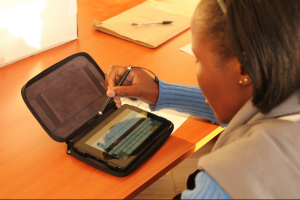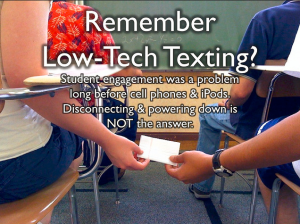I recently read a great article by Clay Shirky “Why Clay Shirky Banned Laptops, Tablets and Phones from His Classroom“. It’s an interesting read, one I highly recommend that all individuals with classroom teaching / training responsibilities engage in.
Emphasis on the word “engage” in that sentence.
While I found Shirky’s article interesting, what I am finding even more interesting are the conversations that are emerging around the topic. I’ve seen multiple threads around social media in which someone shares the post, and people ultimately take sides of agreeing or disagreeing with the author. While I don’t agree with everything Shirky writes, I’m very appreciative of him starting a discussion through which we can all learn a great deal.
The title of this post is Why Technology Belongs in a Classroom, so I guess I’ve already tipped my hat as to what side of the debate I support. Let me share some reasons why I feel this way.
Square Pegs, Round Holes
The article starts with “I teach theory and practice of social media at NYU”. I found myself scrolling back to those words as I read the article, as it seemed to represent a disconnect. Banning technology in a class that focuses on the use of social media is like teaching auto repair but not letting the students enter the garage and touch the cars.
To me this speaks to a recurring problem I see in classroom education – the default starting point. If all of my classroom programs start from a place with a teacher/student lecture paradigm already in place, then yes, technology can and will be a distraction. But why do we need to start from that place? We need to break free from the lecture model as a default – it does have it’s place – and stop applying it as a default delivery method for teaching. Learning is about experiencing things and building them into new and existing contexts. Education needs to be about creating the experiences through which people can learn. Technology is an amazing tool to help build those experiences, if we embrace it and look at our classroom approaches differently.
The Elephant, The Rider, and the Workplace
Shirky references Jonathan Haidt’s metaphor of the elephant and the rider in his post. The metaphor refers to an elephant – your emotions – with a rider – your intellect- on top. The rider plans things logically, but the elephant is powerful and difficult to control. When the rider and the elephant are in conflict, the elephant usually wins. I’ve liked this metaphor since I first read about it in Julie Dirksen’s book “Design for How People Learn”. I completely agree with Shirky’s assessment that social media can be a distraction, and despite the rider logically wanting to pay attention, the lure of the text message or facebook notification popping up is irresistible to the elephant.
Which is another reason why I think the technology SHOULD be in the classroom, especially the college classroom.
I know, that doesn’t seem to make sense, does it? But hear me out.
Workplace education is mostly about task. Most workplace training departments focus on what you need to to do your job more effectively. Workplaces aren’t generally interested in elephants, riders, and helping workers better manage focus in an increasingly distracting world. I’m not saying that’s right; I’m just saying it’s the norm.
College education isn’t as focused on task. I see it as more focused on understanding and preparation for the task. College is also about prepping young people to be productive members of society in general, to help them navigate the world they will be entering.
Well, the world has changed a lot in the last decade. We are a society that is always plugged in, carrying the limitless information of the internet and the connections it enables with us at all times. Maintaining focus in this new world is a challenge, and something people do need to understand how to do.
How do workplaces support this? By blocking social media sites like facebook and Twitter from their IT firewalls. That’s the equivalent of putting a blindfold over the elephant’s eyes to distract him from food when he can still smell it. Just because I can’t access facebook on my desktop doesn’t make the ping from my phone less distracting, and it doesn’t help me maintain my focus. Banning technology from a classroom might help me maintain higher levels of focus in the moment, but it’s not helping me learn how to be focused in an always on world. If anything, it’s pretending that world doesn’t exist. If we’re going to prepare young people to be productive members of society while in college, I don’t think we should block the environment of the real world from their education.
Today’s educators need to understand where technology enhances classroom experiences and where it hinders it, so we can build programs that support both. More importantly, educators need to accept that sometimes technology doesn’t enhance or detract – it is just present as part of a new normal that we need to adjust to.
That brings me to my last point.
The World has Changed, Education Must Adapt
Technology has radically changed the ways we live our everyday life. We live in a constantly online world, with the connections of the internet as ever-present as the air we breathe. We often talk about how technology can enhance or distract from education as if technology is still something we are granting permission to enter our classrooms. That type of mindset holds us back as the world continues to move forward at breakneck speeds.
We need to change the questions we as educators ask ourselves about technology. Instead of asking “How can I do what I do in this new technological world?”, we should instead be asking “What opportunities does this new technology open up that can help me be more effective?”. Instead of trying to maintain the status quo in the face of change, we need to embrace the changes going on around us, strive to understand them, and adapt our practices accordingly.
Join the Conversation
As I said in the start of this post, I encourage anyone with classroom teaching / training responsibilities to engage in this discussion. Read Shirky’s post and the comments around it. Start conversations with your colleagues about the subject. This is an important topic, and hearing the perspectives of others will help you contextualize how you see technology enabling or distracting from your own work.










